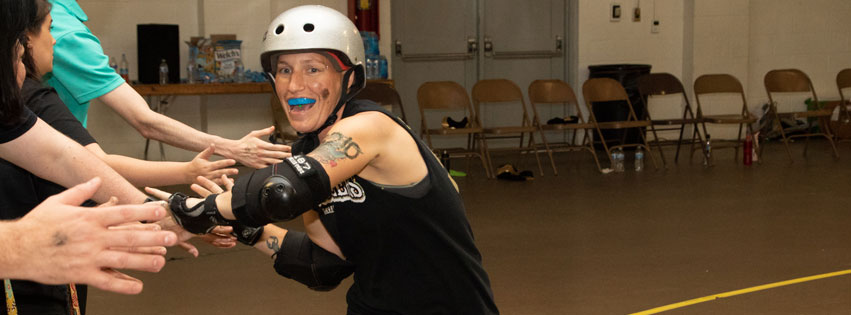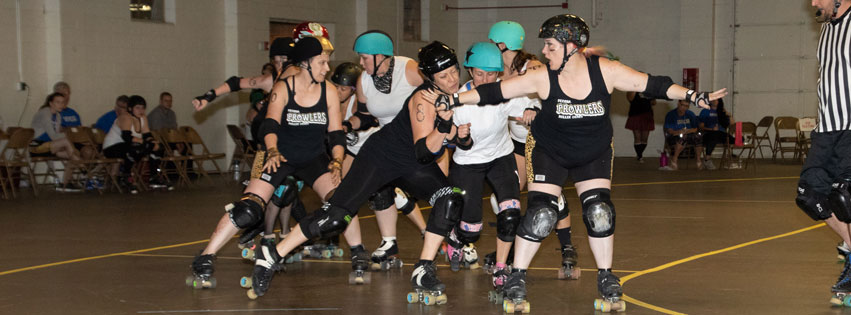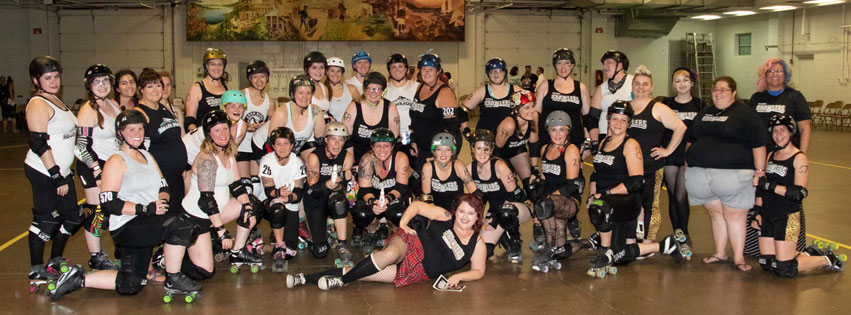Have you watched a roller derby bout? What seems like a chaotic mass of wheels, limbs and glitter is actually a carefully structured, regulated competition among dedicated athletes. But even through the hip checks, jabs and strong hits, there is no ill will among the skaters—in fact, most are part of a tightly-knit group with a bit of flair.
“My favorite thing about derby is probably the people,” says Natalie DeClerck, better known as Natty Slice, a player on the Peoria Prowlers roller derby team. “It’s just a really strong community… Everyone’s supportive and loves the sport.”
The Prowlers, busy preparing for an upcoming June 29th bout at the Peoria Civic Center, have been slowly creeping onto the scene over the past few years. With several devoted players on the team and a growing group of new learners, the league embodies a sport that stands for intensity, quirkiness and a welcoming atmosphere.
The Game & Culture
The game, or bout, takes place in two 30-minute halves made up of “jams” lasting up to two minutes each. Five players from each team—four blockers and one jammer—assemble on an oval-shaped flat track. As the whistle chirps, each jammer takes off, fighting their way through the opposing team’s blockers. The jammer’s goal is to pass all the blockers, and after their initial loop, the jammer gains a point for each additional blocker they pass.
While roller derby is a contact sport, the rules are strict: no use of elbows, hands or legs; otherwise, a player ends up in the penalty box.

Like any sport, there is a learning curve. “The hardest thing about derby is just starting something new and having to be okay with not being great at something right away,” explains Anna Ober-Sutton, a.k.a. Bloody Knuckle Slamwich. “It’s a challenge to work through things that don’t come naturally to you and be okay with the process.”
The Peoria Prowlers will teach new members, even those with no skating experience. Both men and women are welcome at any age and body type—as well as juniors as young as age six.
“Having our team together, you get all kinds of different people. We do different jobs; we’re different ages; we’re just so different,” notes Coach SparkLee Spitfire (real name: Dianna Bhear). “We do community-service type work; we are a charitable organization. So we do good, we have some fun and we are good friends.”
The History
Roller derby is one of the few co-ed sports, which has been the case since its inception. Back in the 1930s, “walkathons” were popular, and sports promoter Leo Seltzer came up with the idea of putting athletes on roller skates. The first Transcontinental Roller Derby opened in 1935 in Chicago, with men and women skating the distance between New York City and San Diego—all 3,000 miles—on a banked track. These competitions would last over a month!
In 1937, the sport took a new turn to include physical contact, teams of five, and a set of rules similar to that used today. As the decades passed, roller derby became a televised event including staged, often wildly theatrical elements of feigned violence along the lines of professional wrestling matches.

Modern roller derby, however, did away with these campy, superficial components, evolving into a more athletic endeavor. In 2000, the Texas Rollergirls of Austin, Texas began a worldwide movement, kicking the sport back into gear after a hiatus in the 1970s.
Today, most teams practice on a flat, rather than banked, track. Hundreds of leagues exist around the world, and skaters from 38 countries participated in the 2018 Roller Derby World Cup. The Women’s Flat Track Derby Association, the leading roller derby organization, helps to regulate the sport’s international following. A men’s and junior’s association also exist today.
“It’s a sport that empowers women. It’s full contact, so it changes the way people think about women in sports,” Spitfire explains. “We can do full contact, we can have full makeup on, we can be fancy, it can be fun, and it’s still something that’s very challenging and athletic.”
The Atmosphere
The Prowlers practice twice a week, but often get together outside of the track. As a nonprofit organization, the league partners with other charities, participates in community events, and makes appearances across the region.
At the end of the day, adds referee Daniel Miller, a.k.a. Dapper Dan, “You have people to inspire you, encourage you, and participate with you as you practice and learn.”
League secretary Sassy PantsNaBunch (real name: Stephanie O’Roake), agrees: “Being a Prowler is important to me because there’s a sense of comradery… We all support each other.” PM
Learn more or get involved at prowlersderby.com.




